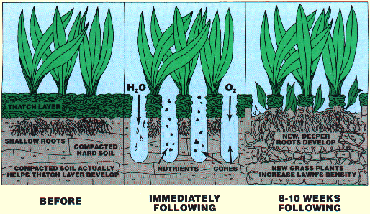Aeration
Crater LAndscape Aeration Spot 031114.mp3




Lawn Renovation: Aeration | ||||||||||||||||||
What Is Aeration? Technically speaking, aeration is the naturally occurring process of air exchange between the soil and its surrounding atmosphere. Practically speaking, aeration is the process of mechanically removing small plugs of thatch and soil from the lawn to improve natural soil aeration. It’s commonly called “core aeration” in the lawn service industry, and you may have heard of it as soil cultivation (coring, spiking and slicing). Most homeowners simply call it aeration. Aeration Benefits: Core aeration can help make your lawn healthier and reduce its maintenance requirements through these means:
Aeration Equipment Affects The Outcome... The type of aeration equipment can determine how effective the treatment will be. In general, turf responds best when core holes are close and deep. Equipment with hollow tines removes soil cores. Equipment with open tines divots the soil surface. Aeration equipment also varies in tine size up to | ||||||||||||||||||
| ||||||||||||||||||
How Often Should You Aerate A Lawn? Most lawns benefit from annual aeration. Heavily used lawns, or those growing on heavy clay or subsoils may need more than one aeration each year. Again, turf responds best when tine spacing is closer and penetration is deeper. When Is The Best Time To Aerate Lawns? If you have cool season turfgrass such as Kentucky bluegrass and perennial ryegrass, both spring and fall are ideal times to aerate. In spring, aerate between March and May. Perform fall aeration between August and November. Aeration before or at the time of late season fertilization enhances root growth and improves spring green-up and growth. Warm season turfgrasses such as zoysia grass and Bermuda grass should be aerated in mid-spring to summer. Avoid aerating when warm season grasses are dormant – it may encourage weed competition. In addition, avoid aerating warm season grasses during spring greenup, and not until after their first spring mowing. |
What is the cost of Aeration? Typically the average property has 3000-6000 square feet of grass. Our Price on these are $50.00. There are certain properties that we charge more due to access problems or steep terrain. If you have a larger property let us know and we can quote you a price.
Did you know people who have their lawn aerated save 2-3 times the cost of the aeration in water and fertilizer costs. Average person saves over 100 dollars just in water alone. Run off can cost.
If you have more square footage or acreage please call and we can give you a quote. The more acreage you have the better price we can offer you.
Call us now to set up your aeration! 951 -3636